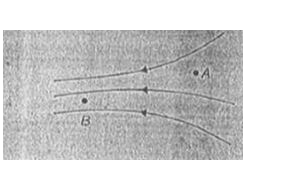The work done in carrying a charge of 5μC form a point A to a point B in an electric field is 10mJ. The potential difference (VB−VA) is then
+2kV
−2kV
+200V
−200V
The correct Answer is:A
To find the potential difference VB−VA when carrying a charge from point A to point B in an electric field, we can use the relationship between work done, charge, and potential difference. The formula we will use is:
W=Q⋅(VB−VA)
Where:
- W is the work done,
- Q is the charge,
- VB−VA is the potential difference.
Step 1: Identify the given values
- Work done W=10mJ=10×10−3J
- Charge Q=5μC=5×10−6C
Step 2: Rearrange the formula to find the potential difference
We can rearrange the formula to solve for VB−VA:
VB−VA=WQ
Step 3: Substitute the known values into the equation
Now we can substitute the values of W and Q:
VB−VA=10×10−3J5×10−6C
Step 4: Calculate the potential difference
Now, perform the calculation:
VB−VA=10×10−35×10−6=105×10−310−6=2×103=2000V
Final Answer
Thus, the potential difference VB−VA is 2000V.
---
- W is the work done,
- Q is the charge,
- VB−VA is the potential difference.
- Work done W=10mJ=10×10−3J
- Charge Q=5μC=5×10−6C
We can rearrange the formula to solve for VB−VA:
Now we can substitute the values of W and Q:
Now, perform the calculation:
Thus, the potential difference VB−VA is 2000V.
Topper's Solved these Questions
- ELECTRIC POTENTIAL & CAPACITANCEBook:A2ZChapter:ELECTRIC POTENTIAL & CAPACITANCEExercise:Capacitor
Explore 32 Videos
- ELECTRIC POTENTIAL & CAPACITANCEBook:A2ZChapter:ELECTRIC POTENTIAL & CAPACITANCEExercise:Capacitor With Dielectric
Explore 32 Videos
- ELECTRIC POTENTIAL & CAPACITANCEBook:A2ZChapter:ELECTRIC POTENTIAL & CAPACITANCEExercise:Electric Potential Energy
Explore 22 Videos
- ELECTRIC CHARGE, FIELD & FLUXBook:A2ZChapter:ELECTRIC CHARGE, FIELD & FLUXExercise:Section D - Chapter End Test
Explore 29 Videos
- ELECTROMAGNETIC INDUCTIONBook:A2ZChapter:ELECTROMAGNETIC INDUCTIONExercise:Section D - Chapter End Test
Explore 30 Videos
Similar Questions
Knowledge Check
The work done in carrying an electron from point A to a point B in an electric is 10 MJ. The potential difference (VB−VA) is then
A+2kVB−2kVC+200VDNone of theseIn figure two points A and B are located in a region of electric field . The potential difference VB−VA is
 APositiveBNegativeCZeroDNone of these
APositiveBNegativeCZeroDNone of theseWhen a 2μC charge is carried from point A to point B, the amount of work done by the electric field is 50μJ. What is the potential difference and which point is at a higher potential ?
A25V,BB25V,AC20V,BDboth are at same potential.
How much work will be done in bringing a charge of 400μC from infinity to some point P in the region of electric field ? Given that the electric potential at point P is 20 V ?
View Solution20 J of work has to be done against an existing electric field to take a charge of 0.05 C from A to B. How much is the potential difference VB−VA ?
View SolutionThe work done in moving a charge from one point to the other is 20J. If the potential difference between the points is 10V, the charge is:
View Solution15 joule of work has to be done against an existing electric field to take a charge of 0.01 C from A to B. Then the potential difference (VB−VA) is :-
View SolutionHow much work is done in moving a charge of 5C across two points having a potential difference of 16V?
View Solution
